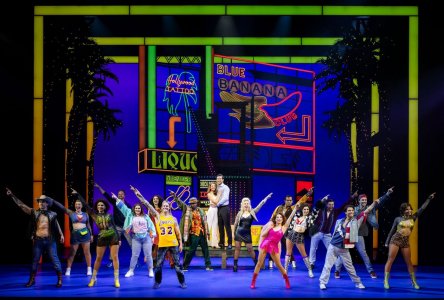
MAHABHARATA - PERTH FESTIVAL 2025
MAHABHARATA, Why Not Theatre, Canada and Perth Festival at His Majesty’s Theatre, 8-16 February 2025. Photography Michael Cooper, David Cooper and Foteini Christofilopoulou
BY VICTORIA LAURIE
In 1988, I sat from dusk to dawn watching Peter Brook’s English dramatisation of the Mahābhārata, staged in the dramatic setting of a stone quarry in the Perth hills. The elements of earth, water, and fire were used to convey this timeless Indian classic, ending with the morning breeze.
It says much about climate change in the intervening nearly four decades that such a location is unthinkable in 2025. Summer temperatures nudging 40C in Perth are now common, with heat stress and fire danger too high even for risk-taking theatremakers.
Hence Perth Festival’s new rendering of the Indian folk epic is staged in an overly chilly air-conditioned theatre. Performed by Toronto’s Why Not Theatre, it’s billed as “the first major international adaptation of the Mahabharata led by artists of Indian heritage” and is cast exclusively from Canada’s Indian and South Asian diaspora.
Does this make it “truer” to the ancient Sanskrit epic? Certainly, it’s in stark contrast to Brook’s legendary production with its single actor of Indian origin and criticism in some quarters as a blatant appropriation of Indian culture. Yet Brook’s cast was also memorably cosmopolitan, featuring actors from several continents – northern Africa, South Asia – where some communities are as familiar with Hindu scriptures as Delhi-based devotees.

This Canadian-Indian Mahabharata is pacy, and bold and captures the zeitgeist. Female actors play some traditional male roles, and vice versa. Anaka Maharaj-Sandhu (self-described as “a gender-fluid” artist) plays the prince Arjuna, and silver-haired Sukania Venugopal (a Malaysian-born female actor) has a commanding presence as military statesman Bhishma.
Brook’s epic ran nine hours, with communal meal breaks. This streamlined version is two parts of roughly two-and-a-half hours each (with intervals and communal meals) that theatregoers can experience sequentially or across different nights.
Why Not Theatre’s artistic director Ravi Jain and Miriam Fernandes, who plays the Storyteller, co-created the show with 17 performers and six musicians. It begins with the elements of traditional storytelling: a fire within a circle and musicians and performers stepping in and out on the storyteller’s cue. They are dressed in rich saffron, soft gold, or burnished orange, against which palette Fernandes stands out in simple blue-green.
The thematic blend of east and west, modern and classical, extends to John Gzowski and Suba Sankaran’s music of electric guitar, tabla, bamboo flute, and singers performing raga melodies. Sankaran describes the composers’ aim as “connecting the cultural dots.” The diminutive Fernandes is a seductive guide, articulating every word as she leads us into a deep forest and the tangled tale of two feuding clans.
The first part, Karma (translated in the notes as fate, or The Life we Inherit), introduces the rival yet blood-related Pandava and Kaurava clans and how they grapple with cycles of violence triggered by their ancestors’ actions. In part two, Dharma (empathy, or The Life we Choose), apocalyptic war is unleashed between the clans and half-siblings. Yudhishthira (Shawn Ahmed), king of the Pandavas, confronts a battlefield of corpses, observing that victory feels like a defeat. Blind king Dhritarashtra (Ravin J Ganatra), who has lost 100 sons on the opposing side, joins him in musing about how such a tragedy could have occurred. Inevitably, the drama triggers thoughts of current wars. A twice repeated line is “When one prefers one’s own children to the children of others, war is near.”

The co-creators approach the work with a directness and lively touch that immerses viewers in a torrent of emotions, rather than assuming we will remember every twist and turn of plot. There are wry moments – a petulant prince who resents sharing his kingdom when all he wants is prosperity “at all costs.” An insouciant Lord Krishna (Neil D’Souza) tells him to give his cousins back what is rightfully theirs, and mocks the prince’s murderous loyalty to deities, playfully asking, “I ask what has God ever done for you?”
There are wonderful dance sequences, in which entire armies are conjured up by actors mimicking their advance, stringing invisible bows and letting fly. A highlight is Ellora Patnaik as Kunti, mother of the Pandavas whose expressive hands mime the moment of conception, a swelling belly, and the birth of an invisible baby. Another highlight (perhaps parochially because he is Perth-based) is dancer-actor Jay Emmanuel as a spinning Shiva, God of Destruction.
The second half is slightly less well-paced and had a few technical glitches on the night. The singers of part one are gone, replaced by electronic recording, giant screens, live video, and chandeliers. A 15-minute opera of the Bhagavad Gita, the Song of God, is sung sublimely in Sanskrit by Mehri Pavi, a heart-stopping vision bathed in brilliant yellow from crowned head to bare feet and framed by psychedelic images on a huge screen. Its somewhat cosmic hippy feel is probably fitting for a God song.
Fernandes observed in an interview that western audiences tend to want to be told right or wrong, or presented with good guy/bad guy. “We want a lesson and a moral at the end, like the Bible gives us,” she said. “And Mahabharata is not that. It contradicts itself, and it’s like Indian culture – it gets more and more confusing and it’s up to you to solve it.”
In the final seconds, I found myself leaning forward keenly to catch the storyteller’s last words. “Om shanti om,” she whispers and then translates the Hindu mantra. “Peace, peace, peace.”
Comments
Leave a Comment
Enter your username and password to comment. Don't have a username? Register now.

-c444x300.jpeg)


Be the first to leave a comment below